Leadership
What is leadership style? 6 emotional leadership styles in workplace

There are individuals who, despite having exceptional expertise that earns them respect, struggle to succeed in leadership roles. Some leaders, on the other hand, may not be extraordinarily talented but are well-loved by their teams and achieve great success. The key difference lies in their leadership style.
Daniel Goleman, a renowned psychologist and accomplished author, has pointed out that leadership style can account for up to 30% of a company's profitability.
He has also categorized and explained the six most common leadership styles, based on research into the close relationship between emotional intelligence and leadership effectiveness - referred to as emotional leadership styles.
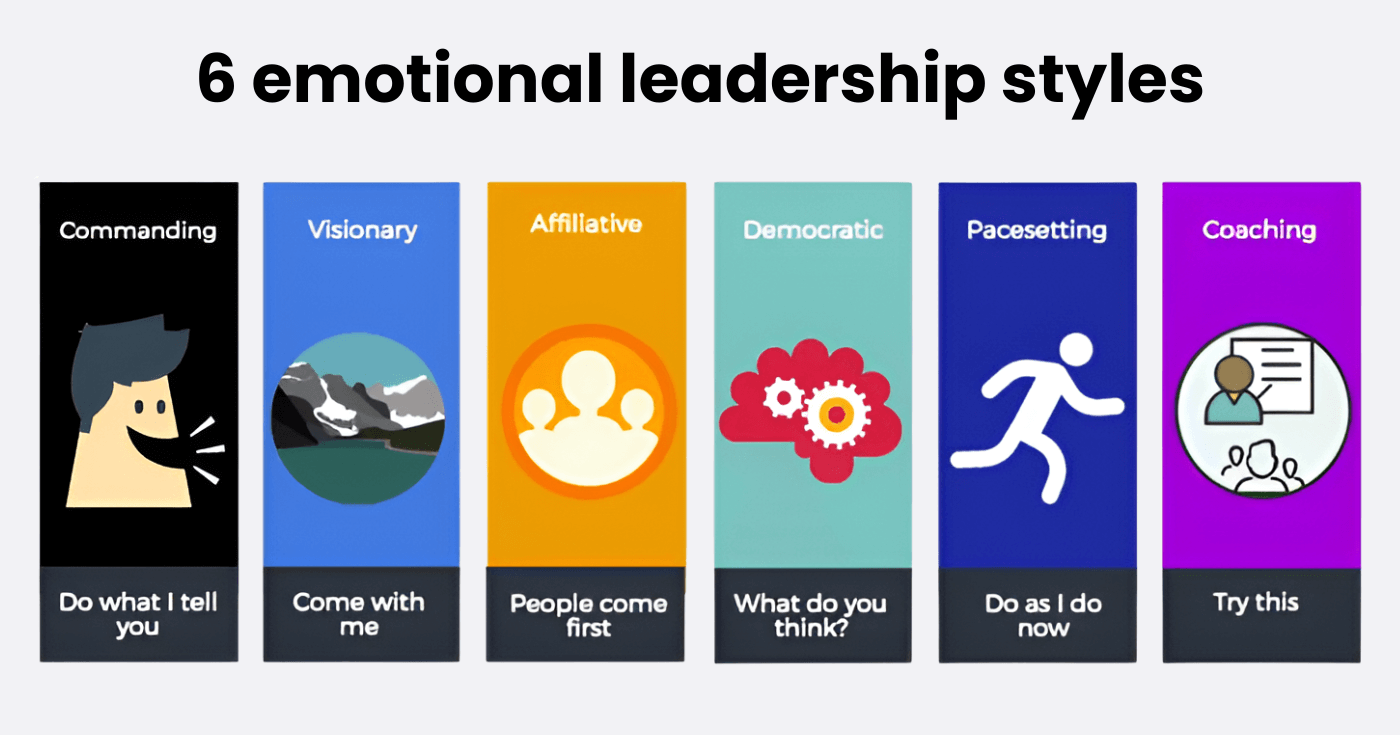 The 6 emotional leadership styles according to Daniel Goleman's research are Commanding, Visionary, Affiliative, Democratic, Pacesetting, and Coaching.
The 6 emotional leadership styles according to Daniel Goleman's research are Commanding, Visionary, Affiliative, Democratic, Pacesetting, and Coaching.
Introduction
First, make sure you understand "leadership style" and "emotional intelligence"
What is leadership style?
Leadership style refers to how a leader organizes, manages, and interacts with their team or organization. It encompasses the methods, attitudes, and behaviors that a leader uses to influence others, achieve organizational goals, and build effective relationships with employees. For a deeper exploration of this topic, see our guide on what leadership truly means.
Leadership styles can vary greatly and are often influenced by the leader's personality, specific circumstances, and organizational culture.
Leadership vs. Management
It's also important to understand the distinction between two closely related concepts in human resource management - leadership and management. While leadership focuses on vision planning, inspiring, and innovating, management emphasizes planning, organizing, and controlling daily activities. For a detailed comparison, read our article on leadership versus management.
What is emotional intelligence?
Emotional intelligence (EI), often referred to in the context of an individual's emotional intelligence quotient (EQ), describes a person's ability, skills, and self-awareness in recognizing, assessing, and managing their own emotions as well as the emotions of others.
Great leaders usually have a strong sense of emotional intelligence. They understand their own emotions, recognize their importance, and understand how their emotions can affect others. In addition, they are perceptive enough to discern the emotions of others, allowing them to respond in a way that promotes positive outcomes.
So, what is emotional leadership style?
Emotional leadership involves leveraging emotional intelligence to guide and influence the emotions of those around you (such as employees) in the desired direction. Just as a golfer uses different clubs for varying levels of difficulty, exceptional leaders must skillfully apply different emotional leadership styles to suit specific situations.
Without emotional intelligence, even the sharpest and brightest person may struggle to become a good leader. This is a crucial factor that distinguishes the concepts of Leadership and Management in Human Resources study.
A talented leader should master at least four emotional leadership styles, particularly the Commanding, Democratic, Pacesetting, and Coaching styles. Below, we'll explore the unique traits of each emotional leadership style and how to effectively put them into action.
6 emotional leadership styles (and how to apply them)
1. The Visionary leader
The phrase "Come with me" captures the essence of the Visionary (also called Authoritative) leadership style.
This style demonstrates the ability to inspire and guide people towards goals. Unlike the Commanding style, where leaders dictate how employees should achieve the goal, Visionary leaders set the direction without imposing specific methods. As a result, employees are encouraged to come up with their own ideas and plans. This approach aligns with principles found in transformational leadership theory.
 The Visionary leaders tell their teams where they're heading, and let them decide how to get there.
The Visionary leaders tell their teams where they're heading, and let them decide how to get there.
When to apply
The Visionary style is most effective when an organization needs a new direction or when a company must change its business strategy. However, when working with a team that has more experience than you, the Democratic style may be more beneficial. Additionally, if used too frequently, the Visionary style can make the leader appear domineering.
How to build up on your Visionary leadership
This style is built on confidence and empathy. Therefore, to develop this leadership skill, alongside enhancing your expertise and "visionary" skills, you must also cultivate confidence and empathy with those around you. Embrace change enthusiastically and let your employees see that passion.
You also need to persuade others about your vision, so improving your presentation skills is highly recommended.
Example
Imagine you are the head of the sales department. To achieve the goal of increasing sales, you introduce a new plan to boost product demand. This process is entirely different from what your team is accustomed to. When you announce it to the group, your excitement and unwavering belief in the plan are evident.
Your team immediately picks up on your enthusiasm and sincerity, and they feel motivated. They understand that the success of implementing this new process depends on them, so they are willing to put in extra effort to learn the new skills required for the job.
2. The Coaching leader
A Coaching leader is easily recognized by their familiar phrase: "Try this."
This style focuses on the personal development of employees, showing them how to improve their abilities and helping them align their personal goals with those of the organization.
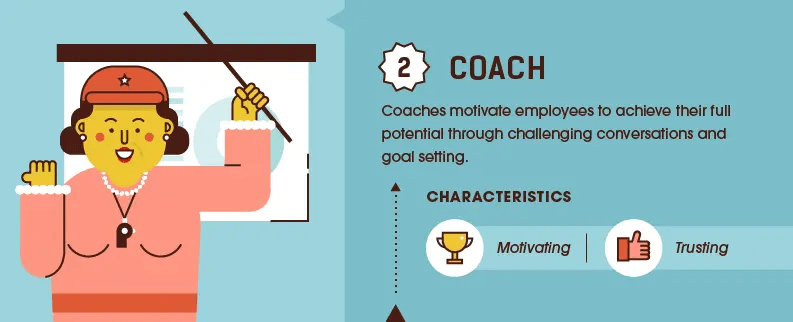 The Coaching leaders support employees to reach their full potential by setting goals and challenges
The Coaching leaders support employees to reach their full potential by setting goals and challenges
When to apply
Goleman notes, "Coaching is most effective with employees who want to demonstrate their talents and are seeking professional growth." You should apply this style when a team member needs help developing long-term skills or if they are falling behind and could benefit from coaching or mentoring.
However, the Coaching style can backfire if it is perceived as micromanagement.
How to build up on your Coaching leadership
Effective coaching requires a leader to truly understand their employees, and to know when the employee needs advice or guidance. Tools like DISC profiles or the MBTI personality tests, commonly used in human resource management, can help you gauge your employees' personalities.
Example
X, a new employee in your department, is struggling to adapt to the job. During the first month, he shows dissatisfaction and a lack of confidence.
You meet with X and encourage him to use the company's library, where he can visit during lunch breaks to learn new skills. You also assign him projects that expand his knowledge base to inspire and motivate him. Instead of feeling overwhelmed, X shows excitement about the opportunity. Soon after, he approaches his tasks with dedication.
3. The Affiliative leader
Guided by the principle "People are the most important asset", the Affiliative leadership style focuses on building harmony and emotional connections among team members. Leaders who adopt this style encourage inclusivity and collaboration, helping the team resolve conflicts together. To achieve this, you must respect others' emotions and value their emotional needs.
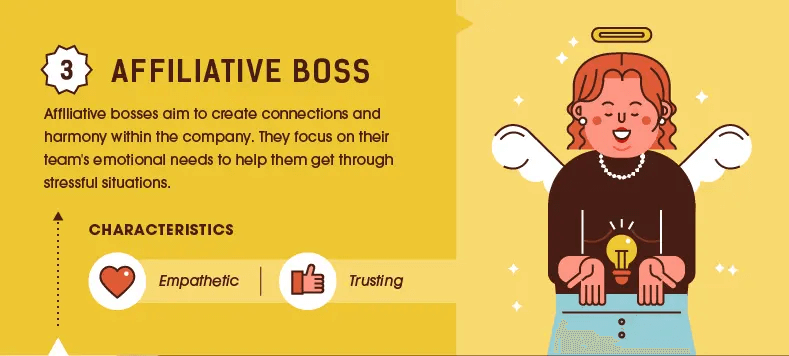 The Affiliative leaders focus on employees' emotions to create harmony and reduce work pressure
The Affiliative leaders focus on employees' emotions to create harmony and reduce work pressure
When to apply
As it prioritizes cooperation, the Affiliative style is particularly effective in mending relationships after conflicts or disagreements that have eroded trust among employees. Additionally, this style is ideal for motivating your team during challenging times or after stressful projects.
How to build up on your Affiliative leadership
To employ the Affiliative style, a leader must pay special attention to people's emotions. When used correctly, this approach can significantly enhance group cohesion, boost employee morale, improve communication, and resolve certain organizational issues.
Understanding conflict resolution techniques and learning how to maintain a positive outlook is essential for anyone looking to adopt this leadership style.
Example
You have been chosen to take on the role of department head, replacing a previous manager known for their authoritarian leadership style. While excited about the opportunity, you face a department that has lost faith in leadership due to past conflicts. You decide to focus on rebuilding trust among the team before diving into work.
After two meetings where employees openly share their experiences under the former manager, the team becomes more open and communicative. With their emotional needs acknowledged, the group is now ready to tackle new projects and objectives.
4. The Democratic leader
"What's your opinion?" is a common phrase used by the Democratic leaders.
For these leaders, collaboration is paramount. They value their employees' opinions and therefore spend more time listening than directing. The Democratic style fosters consensus and collective agreement by involving many people in the decision-making process. This approach shares similarities with the democratic approach in classic leadership styles.
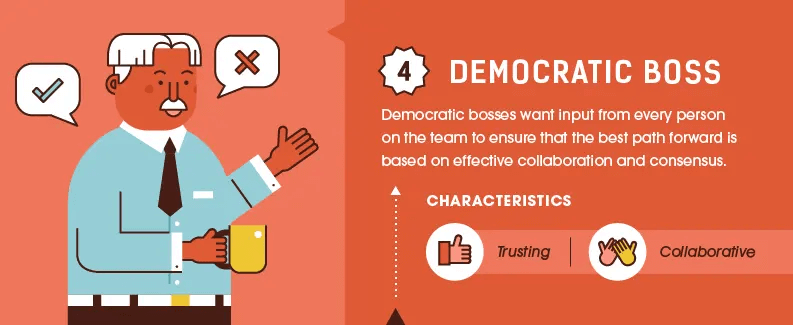 The Democratic bosses encourage employees to contribute ideas and make decisions based on cooperation and consensus.
The Democratic bosses encourage employees to contribute ideas and make decisions based on cooperation and consensus.
When to apply
This style is most effective in situations where teamwork and new ideas are needed. It works well with enthusiastic, knowledgeable team members who are capable of contributing meaningfully. However, if your team consists of inexperienced, unskilled members or those who lack sufficient information about a situation, this style may not be as effective.
How to build up on your Democratic leadership
To enhance your Democratic leadership skills, involve employees in problem-solving and decision-making processes, and teach them the necessary hard and soft skills to contribute effectively. The core of this style is collaboration and communication, so leaders should also work on improving active listening skills and their ability to motivate and inspire employees.
Example
The company's sales have significantly declined during the last two months of the year, and you are deeply concerned. You decide to hold a company-wide meeting to explain the situation. You ask your employees to share any ideas they might have to solve the problem. For the rest of the meeting, all you do is listen. Team members are free to voice their opinions, and together, you and the team agree on the next steps based on the discussions.
5. The Commanding leader
The phrase that characterizes the Commanding leadership style is: "Do as I say."
Leaders who adopt the Commanding (or Coercive) style are known for their authoritative and often forceful approach. They typically rely on issuing orders, using threats, or enforcing strict penalties to maintain tight control over situations.
Because this is an intense style that can easily hurt employees' pride, using it inappropriately can lead to negative consequences.
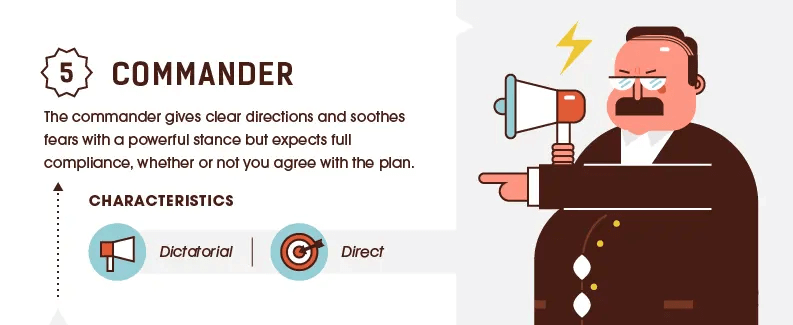 The Commanders give orders loud and clear, forcing employees to obey whether they want to or not
The Commanders give orders loud and clear, forcing employees to obey whether they want to or not
When to apply
Leaders should consider employing the Commanding style in crises, when facing significant changes, or when dealing with uncooperative employees.
How to build up on your Commanding leadership
The foundation of this style is proactivity, autonomy, and the drive to get things done. It's important to use the Commanding style cautiously—do not overuse it, and reserve it for situations where it is truly necessary. To work effectively under high-pressure circumstances, leaders should develop crisis management skills, learn to think fast, and make rapid decisions.
Example
The company's CEO has resigned, and as the Vice President, you are a candidate for the position. However, the Board of Directors is in turmoil, unsure of how to respond to the company's declining stock prices.
You realize that someone needs to take charge. Using your authority, you command the room into silence and outline the necessary steps. The fear subsides, and actions are swiftly taken. Once the crisis is over, you shift to a Democratic leadership style, discussing the next steps with the executive team.
6. The Pacesetting leader
Leaders who adopt the Pacesetting style often say, "Do as I do, now!"
They continuously strive to work better and faster, expecting everyone to do the same. Consequently, this style is highly focused on performance and achieving goals. This results-oriented approach has some parallels with transactional leadership theory.
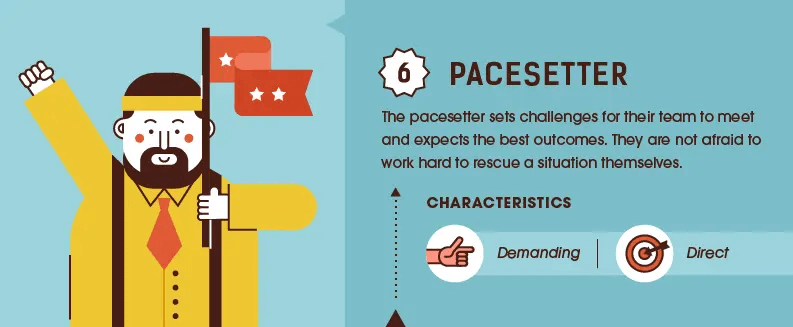 The Pacesetters lead without fear of hardship, always set bigger challenges, and expect the best results
The Pacesetters lead without fear of hardship, always set bigger challenges, and expect the best results
When to apply
The Pacesetting leadership style is best utilized when you need excellent results in a short time, especially when your team is enthusiastic, capable, and does not require close supervision. With a leader who sets a high standard and motivates effectively, employees are often eager to contribute their best efforts.
However, this style should not be overused, as excessively high expectations can lead to employee burnout, decreased morale, and feelings of inadequacy. This can contribute to a higher turnover rate.
How to build up on your Pacesetting leadership
Since this style emphasizes high performance, you should focus on training your employees to maximize their potential and achieve the highest efficiency possible. This strategy should begin with hiring the right people and implementing a thorough onboarding process for new employees.
Example
Even though the holiday season is approaching, your boss is pressuring you to increase sales by the end of the quarter, leaving only a few short weeks to achieve the goal. Meanwhile, your team is beginning to slack off before the extended break.
You understand that your capable employees can handle the pressure and that meeting the performance goal will earn them a great year-end bonus. Therefore, you decide to maintain a high level of productivity—requiring everyone to work extra hours to ensure the plan is executed. You lead by example, working overtime yourself and helping anyone who falls behind.
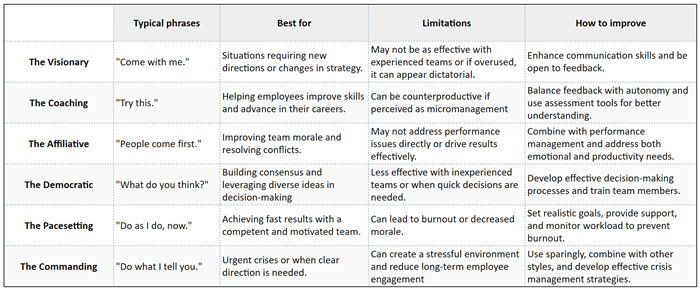
How to find your leadership style?
To find your leadership style, start by understanding your strengths, values, and how you naturally interact with others. Once you have a sense of your leadership style, it's important to stay adaptable. No single style fits every situation. The best leaders often blend different approaches to suit their team's needs and the specific context. This adaptability is the core principle behind situational leadership styles.
That said, some styles are best suited for particular circumstances. The Visionary, Affiliative, Democratic, and Coaching leadership fosters a positive workplace as they promote harmony and employee satisfaction. On the other hand, the Pacesetting and Commanding styles may drive results but can also create a tense, hostile atmosphere that ultimately hinders motivation and creativity.
A leader is one who knows the way, goes the way, and shows the way. - John C. Maxwell.
Exceptional leaders not only impress with their knowledge and talent, but also a leadership style that aligns with the organization, resonates with employees, and reflects their true self. When facing difficult situations, their charisma makes the challenges seem less daunting, and goals become more achievable. I hope this article provides valuable insights for your leadership journey.
Learn More
- 5 Levels of Leadership – Understand the progression from positional to pinnacle leadership
- Management Skills – Explore the four levels of management competencies
- Bill Gates Leadership Approach – See emotional intelligence in action
Frequently Asked Questions about Emotional Leadership Styles

Tara Minh
Operation Enthusiast
On this page
- Introduction
- What is leadership style?
- Leadership vs. Management
- What is emotional intelligence?
- So, what is emotional leadership style?
- 6 emotional leadership styles (and how to apply them)
- 1. The Visionary leader
- 2. The Coaching leader
- 3. The Affiliative leader
- 4. The Democratic leader
- 5. The Commanding leader
- 6. The Pacesetting leader
- How to find your leadership style?
- Learn More